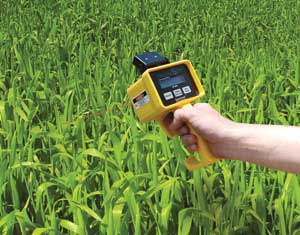NASA Derived Fieldscout® CM1000 Meter

Chlorophyll Measurements Provide Valuable Information for Nutrient Management of Crops and Turf Grass.
 |
| The NASA-derived, point-and-shoot FieldScout meter can take chlorophyll measurements from individual leaves or across a canopy, providing valuable information for nutrient management of crops and turf grass. |
Spectrum now offers its NASA-derived technology as the FieldScout CM 1000 meter, which the company views as a powerful nutrient management tool.
“In the world of nutrient management, nitrogen is one of the key elements for growers to manage,” says Thurow. Nitrogen is a main component of chlorophyll; plants with low chlorophyll levels are thus indicators of poor nitrogen levels in the ground. Growers can respond by providing health-boosting doses of nitrogen fertilizer.
Whereas some chlorophyll meters attach to individual leaves like a clothespin, the FieldScout meter is a point-and-shoot tool that can take measurements from individual leaves or across a plant canopy, making it a fast and accurate way to survey chlorophyll levels not only for crops like cotton or corn, but also for turf (like athletic fields and golf courses) and long grasses like wheat and rice.
“With the NASA-developed meter, from 5 to 6 feet away, you can look at a canopy of close to 7 inches in diameter,” says Thurow. “It integrates a larger sample than other meters, making it faster and easier to use.”
The FieldScout meter takes individual readings with the click of the trigger and also supplies a running average. To provide an extra level of value to the meter’s readings, the user can also log the latitude and longitude of each reading with an optional GPS device and upload this information into Spectrum’s SpecMaps Web-based software utility. SpecMaps then produces a map showing the spatial variability of chlorophyll levels based on the meter’s readings. This helps the user more accurately determine the cause of less-than-ideal readings—perhaps poor soil quality in certain areas—and employ a targeted solution, such as providing fertilizer to only those areas low in nitrogen, allowing for maximum economic yield.
Spectrum also now offers a FieldScout CM 1000 NDVI meter, which measures red (660 nm) and near-infrared (840 nm) light reflectance to calculate a Normalized Difference Vegetation Index (NDVI) for an enhanced analysis of the meter’s spectral data. NDVI was originally developed by Goddard for use measuring the health of plant life from space-based sensors.
Currently, Thurow says the meters’ main users are researchers working with small grains, turf, and rice, and Spectrum is aiming to grow a larger market base among agricultural consultants and growers. Since the NASA-derived meter was introduced by Spectrum in 2001, the company has sold 350 units, resulting in $700,000 of revenue—good numbers for a specialty product, Thurow says. He credits the product’s success to the benefits of partnership.
“I have a strong belief in partnering,” he says. “In our case, NASA had a basic, validated technology that we were able to finish developing. It gave us the opportunity to offer a product that we would never have created on our own. It’s a win-win deal.”
FieldScout® is a registered trademark of Spectrum Technologies Inc.
SpecMaps™ is a trademark of Spectrum Technologies Inc.
